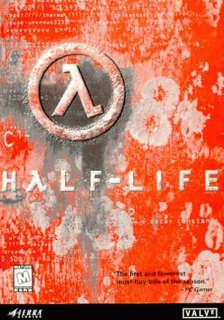It combines a balance of tense action, puzzle solving, story, and fun that has yet to be equaled on in the FPS arena.
The game opens with a great intro that inserts the player into the role of Gordon Freeman on his first day of work at the Black Mesa research facility. Gordon takes part in a mysterious experiment that goes wrong. "Everything's good, Freeman. WHOOPS!" The premise is simple enough, but becomes more complicated when government troops arrive to clean up the situation. Unfortunately they aren't just there to wipe out aliens. The entire staff at Black Mesa is at risk. The fact that there is a plot at all is an accomplishment.
Things aren't just run-and-gun. The player can approach situations with guns blazing but more often than not they'll wind up splattered across a wide area. There are actually strategic elements involved. Sometimes throwing a grenade into a room is a better method. There isn't much of the "find key to unlock blue door" missions. Doors that are locked can sometimes be smashed or blown up. For the most part the player must try to locate a fellow scientist or security member to get a door open. This can require keeping them alive long enough to activate the lock. Freeman has the ability to run, jump, swim and duck, all the basics for someone running from marauding aliens and government soldiers. The player will need to utilize all of them if they hope to navigate the many challenges that lie in wait. The equipment at Freeman's disposal are varied. From the useful crowbar, to satchel charges, to the experimental gauss gun (think proton packs from Ghostbusters), the right weapon for the right situation is essential. Using the shotgun on a head crab isn't as effective as using the 9mm pistol. Balancing weapons can be a challenge. Ammo isn't just dropped in random locations. Freeman has to pick-up ammo from fallen enemies or from their command posts. The same applies to health and energy stations.
The energy stations replenish Freeman's protective HEV suit. The suit protects Freeman somewhat from energy attacks and environmental conditions. The suit also has a bit of a personality. Take some damage and an electronic voice will inform you that "Major blood loss detected. Administering morphine." Falling from a huge distance will result in a crunch noise and instant death with the calm HEV suit informing Freeman that a "major fracture [has been] detected." While this might not have been intended to be funny, it's a great way to break the tension.
And there is tension, lots of it. Dark places will start to make the player think twice. Corners will be approached with caution. The designers made very good use of darkness and shadow to make the player jump. There are also some sections in which a mammoth three story alien bears down on Freeman, it's thundering footsteps getting closer and closer. The player will want to look back. . . Adding to the tension is the enemy AI. The enemies are modeled using skeletal animation making for some fluid motion. The behavior exhibited is solid and nice to look at, even when Freeman is being shredded by machine gun fire. The military infantry are tough as hell and will retreat if necessary. They will also use everything in their arsenal. It's not uncommon to duck behind a crate for cover from a machine gun nest to hear the dreaded "clink clink" of a grenade landing nearby. And some of the aliens demonstrate this ability, regrouping and going on the offensive. There are moments that the infantry can be sneaked up on and dispatched without even twitching. Stranger, is that nearby soldiers won't move either. These instances don't occur often but still detract a little from the overall reality the designers have tried to create. The player is given a bit of a breather between sections.
Instead of having massive load times between levels, HL loads smaller areas quickly to keep as much tension as possible. This also helps in avoiding the artificial sectioning of the game the way Quake II did. In essence, HL is one continuous level.
Half-Life uses the Quake engine, albeit a heavily modified version. Something not seen in Quake though, are bright colours. HL serves up a veritable rainbow of colour with great looking aliens, electrical effects, open desert areas, office spaces, and big explosions. The graphics are sharp and easy to look at. There have been a few patches released in the last couple of years to bring HL up to speed with the latest 3D cards and advancements in network programming. It runs very nicely on today's computers even with the resolution cranked to the max (with a 3D card). The indoor and outdoor environments are excellent. Black Mesa is a big place and this is conveyed nicely. Explosions are big and some of the scenery can be blown up. (And some of the vehicles can be operated) The sound is also good. Playing with the headphones is probably the best way to play. The music is understated and subtle, playing only once in a while, but adding to the tension.
Difficulty ramps up gradually, with Freeman facing more numerous and powerful aliens as the game progresses. The trip to the Xen, the alien stronghold, holds a few of the most challenging and terrifying enemies.
Half-Life is a game that needs to be experienced. It combines a balance of tense action, puzzle solving, story, and fun that has yet to be equaled on in the FPS arena.

